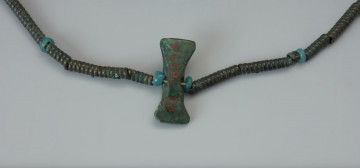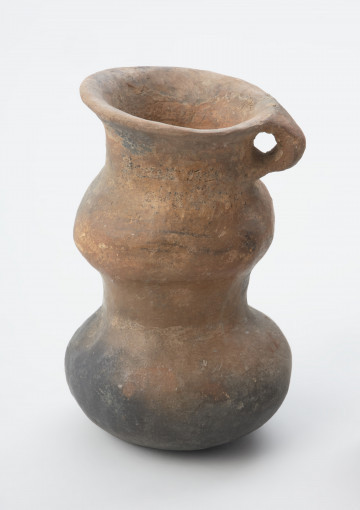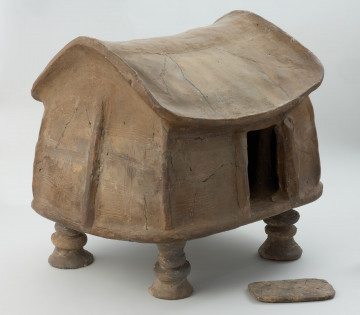
A beaded necklace with pendant
around 1000 p.n.e. — 900 p.n.e.
National Museum in Szczecin
Part of the collection: Bronze Age
It is a long, slender knife with a strikingly curved blade, fitted with a narrow bar to the handle, in which one small rivet has survived. With the help of such small bronze "pegs", a facing was attached to the handle, most probably made of antler or wood. The knife comes from a barrow grave discovered in early December 1935 during earthworks in Mr Bose's garden. Due to the severe frosts, excavations led by Hans Jürgen Eggers, a Szczecin archaeologist, did not start until spring 1936. In effect, the remains of a rectangular stone pavement measuring 3 × 4 m were uncovered, which contained burnt remains of human bones and grave goods - 62 items in total, including four earthenware vessels and various bronze objects (e.g. a bead necklace, hoop necklaces, bracelets, pins, a fibula, knives, tweezers, a razor, buttons, rings). The whole was covered by a layer of stones forming a mound. The whole ensemble ended up in the collection of the Pommersches Landesmuseum in Stettin (Polish: Pomorskie Muzeum Krajowe w Szczecinie; English: Pomeranian State Museum in Szczecin), where it remained until it was evacuated deep into Germany at the end of World War II. Since 2009, all the artefacts are housed in the National Museum (Muzeum Narodowe) in Szczecin. The barrow from Banie, dated to the 2nd half of the 4th Bronze Age (approx. 1000-900 BC), is the only archaeological find of this type from the younger Bronze Age in Pomerania. Due to the richness of its furnishings, it gained the name of a ducal tomb in scientific literature. The number and quality of the gifts indicate that a person of high social rank was buried there. The bronze artefacts were produced in local Pomeranian metallurgical workshops, but the pattern of the presented knife originates from the distant Western Alpine zone.
Dorota Kozłowska
Author / creator
Dimensions
the entire object: height: 26 cm, width: 2 cm
Object type
knife, weapon
Technique
riveting, casting
Material
bronze
Origin / acquisition method
legal transfer
Creation time / dating
Creation / finding place
Owner
National Museum in Szczecin
Identification number
Location / status

around 1000 p.n.e. — 900 p.n.e.
National Museum in Szczecin

around 1100 p.n.e. — 750 p.n.e.
National Museum in Szczecin

around 750 p.n.e. — 550 p.n.e.
National Museum in Szczecin
DISCOVER this TOPIC
National Museum in Szczecin
DISCOVER this PATH
Educational path